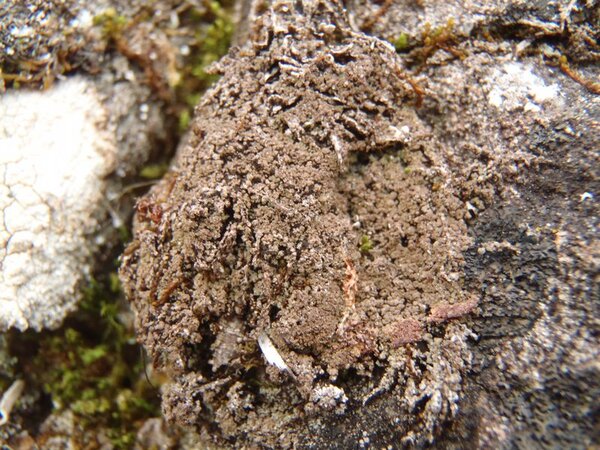Rinodina mniaroeiza (Nyl.) Arnold
Flora, 53: 469, 1870. Basionym: Lecanora mniaroeiza Nyl. - Flora, 53: 33, 1870.
Synonyms: Diploicia muscorum sensu A. Massal.; Rinodina hookeri (Fr.) Dalla Torre & Sarnthein; Rinodina mniaraea f. biatorina (Nyl.) Arnold; Rinodina mniaraea var. mniaraeiza (Nyl.) H. Magn.; Rinodina mniaraeiza (Nyl.) Arnold
Description: Thallus crustose, episubstratic, thin, continuous, effuse, granular-verrucose, whitish to pale grey, rarely pale brown, without a distinct prothallus. Medulla white, with crystals soluble in K. Apothecia lecanorine, 0.6-0.9 mm across, usually crowded, adnate to sessile, with a dark brown to black-brown, epruinose, flat to convex disc, and a thin, entire, prominent, usually persistent thalline margin. Thalline exciple 35-70 μm wide laterally, indistinctly corticate, overlain by an epinecral layer; epithecium brownish orange; hymenium colourless, 85-150 μm high; hypothecium colourless to brown, 70-250 μm high, inspersed with oil droplets, especially in older apothecia. Asci 8-spored, clavate, the K/I+ blue tholus penetrated by a faintly amyloid apical cushion with parallel or diverging flanks, the wall K/I-, surrounded by a K/I+ blue outer layer, Lecanora-type. Ascospores 1-septate, brown, ellipsoid, 20-32 x 9-15 μm, Physcia-type, with a well-developed torus and smooth walls, the ontogeny of type A (apical wall thickening after septum formation). Pycnidia dark, immersed. Conidia bacilliform, 4-5 μm long. Photobiont chlorococcoid. Spot tests: K+ yellow, C-, KC-, P+ faintly yellow, UV-. Chemistry: atranorin, and variable amounts of variolaric acid.
Growth form: Crustose
Substrata: soil, terricolous mosses, and plant debris
Photobiont: green algae other than Trentepohlia
Reproductive strategy: mainly sexual
Commonnes-rarity: (info)
Alpine belt: rather rare
Subalpine belt: rare
Montane belt: absent
Dry submediterranean belt: absent
Humid submediterranean belt: absent
Padanian area: absent
pH of the substrata:
1 2 3 4 5
Solar irradiation:
1 2 3 4 5
Aridity:
1 2 3 4 5
Eutrophication:
1 2 3 4 5
Poleotolerance:
0 1 2 3
Altitudinal distribution:
1 2 3 4 5 6
Rarity
absent
extremely rare
very rare
rare
rather rare
rather common
common
very common
extremely common
Loading data...
Occurrence data
Predictive map
Growth form: Crustose
Substrata: soil, terricolous mosses, and plant debris
Photobiont: green algae other than Trentepohlia
Reproductive strategy: mainly sexual
Commonnes-rarity: (info)
Alpine belt: rather rare
Subalpine belt: rare
Montane belt: absent
Dry submediterranean belt: absent
Humid submediterranean belt: absent
Padanian area: absent
pH of the substrata:
| 1 | 2 | 3 | 4 | 5 |
Solar irradiation:
| 1 | 2 | 3 | 4 | 5 |
Aridity:
| 1 | 2 | 3 | 4 | 5 |
Eutrophication:
| 1 | 2 | 3 | 4 | 5 |
Poleotolerance:
| 0 | 1 | 2 | 3 |
Altitudinal distribution:
| 1 | 2 | 3 | 4 | 5 | 6 |
Rarity
absent
extremely rare
very rare
rare
rather rare
rather common
common
very common
extremely common
Loading data...
Occurrence data
Predictive map







